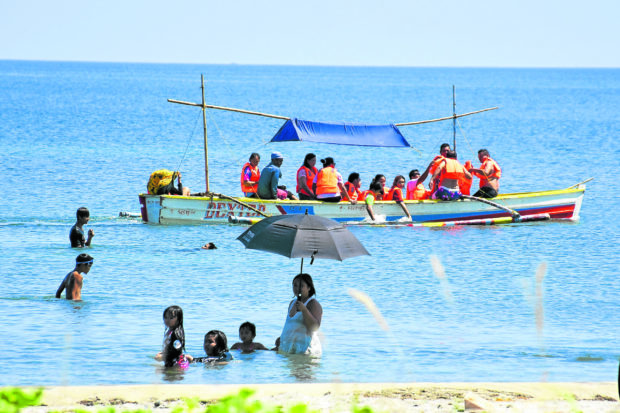
BEAT THE HEAT Residents of Binmaley town in Pangasinan go to the beach to take a quick dip and enjoy the breeze amid the intense summer heat. The nearby city of Dagupan, in recent days, has been recording the country’s highest heat index. —WILLIE LOMIBAO
Residents of Dagupan City in Pangasinan province and Sangley Point in Cavite province experienced sweltering heat that reached dangerous levels, as these areas logged the highest heat index in the country on Wednesday.
At 11 a.m. Wednesday, the heat index in Dagupan was 47 degrees Celsius, while the same was recorded at 2 p.m. in Sangley Point, according to records from the Philippine Atmospheric, Geophysical and Astronomical Services Administration (Pagasa).
Heat index refers to how the human body perceives actual temperatures. High indices are caused by high air temperatures and high relative humidity, according to Pagasa
Temporary relief
On Wednesday, temperatures in Dagupan and Sangley Point reached 35.5 C and 33.3 C, respectively.
Other areas that experienced extreme heat on Wednesday were Aparri and Tuguegarao City in Cagayan province; Ambulong, Batangas province; Laoag City, Ilocos Norte; and San Jose, Occidental Mindoro.
On May 14, Dagupan City reached the highest computed heat index for the year, at 53 C.
But occasional thunderstorms and rain showers being experienced in Pangasinan recently are giving residents temporary relief from the intense heat.
The weather bureau, however, said Pangasinenses would still have to bear with the rising temperature for the next 10 days.
Jose Estrada Jr., chief meteorological officer of Pagasa weather station in Dagupan, said the thunderstorms and rain were not an indication of the start of the rainy season but were due to the high temperature during the day.
“Because of the heat, water evaporates and condenses in the atmosphere, forming convective clouds. These cause thunderstorms in the afternoon or at nighttime,” he said.
It was on April 12, 1915, when the maximum temperature in this city reached a record-high 39.9 C although the heat index then had not yet been measured, Estrada said.
But Pangasinenses can get some reprieve from the scorching heat in the next two weeks when the southwest monsoon is expected to enter the country.
“By then, we can expect a lower temperature,” Estrada said.
He said the rising temperature in Dagupan and the rest of the province could be attributed to the cutting of trees, concreting of roads and other spaces, and high sea surface temperature.
“Dagupan is a coastal city and is affected by high sea surface temperature,” Estrada said.
Heat cramps, exhaustion
Pagasa said with a heat index at 47 C, heat cramps and exhaustion were likely, while heatstroke might occur with continued activity in intense heat.
The Department of Health (DOH) in the Ilocos region has advised residents to stay hydrated by drinking plenty of water to beat heat exhaustion or prevent heatstroke.
“Taking a bath or showering at least twice a day could also save us from ailments caused by heat,” Dr. Magnolia Brabante, chief of noncommunicable diseases center of the DOH in the region, said in a separate interview.
Children 4 years old and below and people who are 65 years old and above are susceptible to heat exhaustion and heatstroke, and must avoid staying outdoors, she said.
Symptoms of heat exhaustion include dizziness, excessive sweating, muscle cramps, rapid but weak pulse, and pale, cold and clammy skin.
“Victims of heat exhaustion must be brought to a cooler place. [They must be given] drinking water, [take a] shower or [applied with a] cold compress,” Brabante said.
Heatstroke, she said, needs emergency treatment at the hospital.